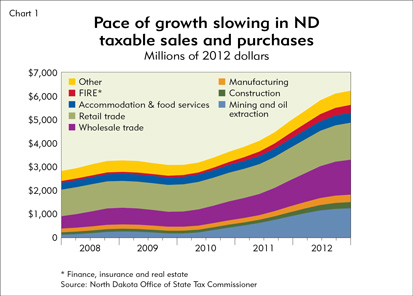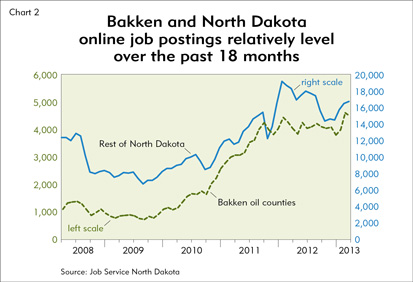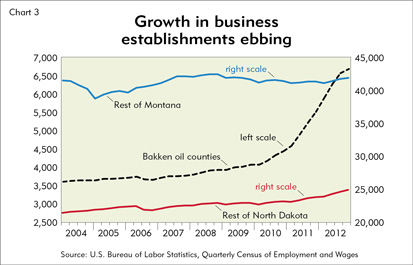Oil and gas production continues to rise in the Bakken and Three Forks formations, but the rapid pace of growth has been easing during recent months—from torrid to simply fast.
Oil production in this region climbed to 24 million barrels during April, or 11 percent of U.S. production (see related charts and data here). However, the number of oil rigs drilling wells in North Dakota has leveled off at an average of 176 from November 2012 through June 2013 after reaching a peak of over 200 in June 2012. Meanwhile, the average number of active drilling rigs in Montana dropped to 10 in June after reaching a peak of 25 in October.
Oil production has continued to grow among the four largest producing counties (North Dakota’s McKenzie, Mountrail, Williams and Dunn), but the pace of growth has slowed relative to oil output in other counties. In April, oil production increased 26 percent over levels a year ago in these four counties, compared with a 51 percent increase among other producer counties in North Dakota. Consequently, oil production in these four counties declined from 84 percent of the state’s oil production in November 2012 to 81 percent in April.
The brisk pace of growth in North Dakota’s taxable sales and purchases slowed during first quarter 2013, dropping to a year-over-year increase of $86 million, or 1.6 percent, down from 9.7 percent year-over-year growth in fourth quarter 2012 (see Chart 1). Slower growth in taxable sales and purchases reflects the modest easing in the pace of economic activity in the Bakken area. In first quarter 2013, taxable sales and purchases in the mining and oil extraction industry decreased 7.3 percent from a year earlier, compared with a more than 100 percent year-over-year increase in first quarter 2012.
Bakken area employers added more than 15,000 jobs from May 2012 to May 2013, while employment in the rest of North Dakota and Montana remained relatively level (see related charts and data here).
The number of online job postings in June was up 11 percent from a year ago in the North Dakota Bakken counties, but down 9 percent in the rest of North Dakota (see Chart 2). In both cases, job posting growth seems to be leveling, especially compared with very strong growth rates from 2010 to 2012.
The largest share of job postings are in the transportation, construction and extraction industries (17 percent of total), followed by sales jobs (11 percent) and office administration jobs (11 percent). In terms of geographical spread, labor demand in the North Dakota part of the Bakken is concentrated in Williams and Stark counties, homes of Williston and Dickinson, respectively, with about 3,700 job postings (78 percent of the Bakken total).
Unemployment rates continued to edge downward, dropping to 1.7 percent in the Bakken area during May compared with 1.9 percent in May 2012. In the rest of Montana, the unemployment rate has been falling from post-recession highs to 5.8 percent. Meanwhile, in the rest of North Dakota, the unemployment rate has been roughly level over the past year, at 3.7 percent in May (see related charts and data here).
Average weekly wages continue to rise in the Bakken counties (see related charts and data here). Average weekly wages grew a robust 9 percent in fourth quarter 2012 compared with a year earlier, but lower than the year-over-year 19 percent wage growth seen in fourth quarter 2011.
A similar trend can be observed in the number of business establishments in the last quarter of 2012, with Bakken counties posting a solid, but slowing, increase (see Chart 3).









